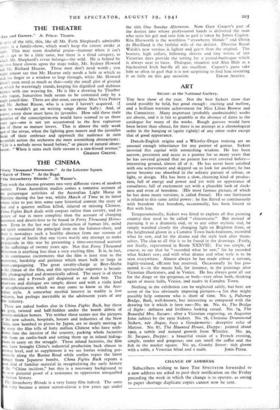THE CINEMA
'Forty Thousand Horsemen." At the Leicester Square.
March of Time." At the Regal.
The Strawberry Blonde." At Warner's.
its week the cinema presents two very different views of modern rfare. From Australian studios comes a romantic account of e picturesque activities of the Australian Light Horse in alestine during the last war, whilst March of Time in its latest elease tries to put into some sane historical context the_story of our and a quarter million killed, injured or missing Chinese. hina Fights Back deals with corpses rather than cavalry, and its icture of war is more complete than the account of charging orsemen and desert-love to be found in Forty Thousand Horse- en. Even in the last war the destruction of human life, mind d spirit remained the principal item on the balance-sheet, and ere is nowadays such a healthy absence from our screens of e glamour of battle that one views warily any attempt to make ropaganda in this war by presenting a time-sweetened account the sufferings of twenty years ago. Not that Forty Thousand orsemen is anything less than a very exciting film. It is, in fact, its continuous excitements that the film is least true to the onotony, hardship and patience which must bulk so large in esert-campaigning. The great cavalry-charge at Beer-Sheba the climax of the film, and this spectacular sequence is beauti- lly photographed and dramatically edited. The story is of three mrades and a French girl disguised as an Arab boy. The tuations and dialogue are simple, direct and with a virile kind unsophistication which we may come to know as the Aus- an style. A somewhat morbid interest in- nudity is less elcome, but perhaps inevitable in the adolescent years of any
industry.
There are naked bodies also in China Fights Back, but these grey, twisted and half-hidden under the bomb debris of verty-stricken homes. Yet neither these scenes nor the pictures the new schools, hospitals, houses and industries of the New na, now bombed to pieces by Japan, are so deeply moving as e story the film tells of forty million Chinese who have with- wn into the interior of the country, packing whole factories th them on coolie-back and setting them up in inland. hiding- laces to carry on the struggle. These inland factories, the film vs, have brought China's industrial production back almost to re-war level, and to supplement it we see lorries winding pre- ciously along the Burma Road while coolies repair the latest amage from Japanese bombs. China Fights Back repeats a eat deal of familiar material in recapitulating the early history the " China incident," but this is a necessary background to e new pictorial proof of a resistance to oppression unequalled human history.
The Strawberry Blonde is a very funny film indeed. The same Ina story became a minor screen-classic a few years ago under the title One Sunday Afternoon. Now Gary Cooper's part of the dentist into whose professional hands is delivered the man who stole his girl and sent him to gaol is taken by James Cagney. Rita Hayworth is the worthless " strawberry blonde " and Olivia de Havilland is the faithful wife of the dentist. Director Raoul Walsh's new version is lighter and gayer than the original. The boaters, high collars, billowing sleeves and tiny waists of late Victorian days provide the setting for a- period-burlesque which is always near to farce. Dialogue, situation and Alan Hale as a big-hearted Irish bar-fly all are excellent. Cagney's parts take him so often to gaol that it is not surprising to find him resenting


































 Previous page
Previous page